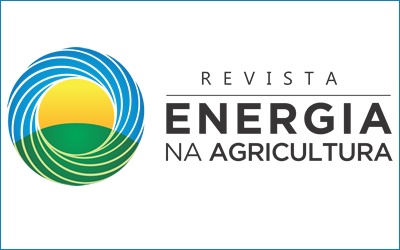CARACTERÍSTICAS AGRONÔMICAS E DEMANDA ENERGÉTICA DE CULTIVARES DE SOJA SOB EFEITO DOS SISTEMAS DE PREPARO DO SOLO
DOI:
https://doi.org/10.17224/EnergAgric.2012v27n4p92-108Resumo
O objetivo deste trabalho foi avaliar a influência dos preparos: grade intermediaria cultivo mínimo e plantio direto nas características agronômicas e demanda energética de cultivares de soja transgênica e não transgênica. O preparo do solo visa à melhoria das suas condições físicas, químicas e biológicas. Objetivando com isso uma boa emergência e desenvolvimento das plantas. Os diferentes tipos de preparo do solo podem interferir nas características agronômicas e produtividade das plantas e no uso de energia, o que pode ocasionar variação nos custos de produção. Plantas geneticamente modificadas podem ser uma das alternativas quanto à redução de custo de produção das lavouras por reduzirem as aplicações de defensivos, possibilitando alta produtividade das mesmas com menor impacto ambiental. O ensaio foi conduzido no ano agrícola 2010/2011, na Fazenda Experimental Lageado, pertencente à Faculdade de Ciências Agronômicas – UNESP, localizada no município de Botucatu - SP, em área cultivada em sistema de plantio direto há 12 anos. O delineamento experimental foi realizado em fatorial 3x2, em blocos casualizados, os tratamentos foram constituídos de três sistemas de preparo de solo, cultivo mínimo, preparo com grade intermediaria e plantio direto e dois cultivares de soja: MGBR-46 Conquista (convencional), Valiosa RR (Transgênica). Os dados obtidos foram submetidos à análise de variância pelo teste de Tukey a 5% de probabilidade. Com os resultados analisados pôde-se observar que houve diferença significativa entre os tratamentos, nas variáveis, porcentagem de cobertura do solo, população final de plantas de soja, produtividade de grãos e altura de plantas. Os resultados obtidos mostram que o sistema de plantio direto resultou em maior produtividade que o preparo convencional e o cultivo mínimo. O maior uso específico de energia por área foi observado no cultivo mínimo com escarificador, quando comparado ao preparo com a grade. O maior consumo de combustível foi no tratamento cultivo mínimo com escarificador. Os maiores valores de patinagem foram encontrados no sistema de cultivo mínimo, sendo maior que no sistema de preparo convencional. É mais satisfatório para o produtor semear a soja transgênica em sistema de plantio direto, pois a produtividade obtida nesse sistema compensa o gasto com combustível.
Palavras-chave: Plantio direto, consumo de combustível, cultivo mínimo.
AGRONOMIC CHARACTERISTICS AND ENERGY DEMAND OF SOYBEAN CULTIVARS UNDER TILLAGE SYSTEMS
SUMMARY: The aim of this study was to evaluate the influence of preparation: intermediate grade, minimum tillage and no-till on the agronomic characteristics and energy demand of transgenic soybean cultivars and non-GMO soybeans. Soil preparation aims at improving physical, chemical and biological conditions, aiming at good emergence and plant development. The different types of tillage may interfere with the agronomic characteristics and productivity of plants, and in energy use which can cause variation in production costs. Genetically modified plants can be one of the alternatives for reduction of production costs in crops by reducing pesticide applications, enabling higher productivity with less environmental impact. The test was conducted in 2010/2011 at the agricultural Experimental Farm Lageado, belonging to the Faculty of Agronomic Sciences – UNESP, located in the city of Botucatu, SP in an area using no-till systems for the past 12 years. The experiment was carried out in a 3 x 2 factorial, randomized treatments were comprised of three soil preparation systems, minimum cultivation, intermediate grade preparation and no-till, with two cultivars of soybeans: MGBR-46 Conquest (conventional), Valuable RR (Transgenic). The data obtained was submitted to variance analysis using Tukey test at a 5% probability. With the results analyzed it might be observed that there was no significant difference between treatments, in the variables, the percentage of soil cover, final soybean plant population, grain yield and plant height. The results obtained show that the no-till system resulted in higher productivity than conventional tillage and minimum cultivation. The higher specific energy use per area was observed in minimum cultivation with a chisel plough, when compared to the preparation across the grid. The greatest fuel consumption was to treat minimum cultivation with chisel plough. The highest values were found in the skating system of minimum cultivation, being greater in conventional tillage system. It is more satisfactory for the producer to sow transgenic soy using a no-till system, because productivity retrieved from that system compensates for fuel expenditure.
Keywords: No-till, fule consumption, minimal tillage.
Downloads
Publicado
Como Citar
Edição
Seção
Licença
Esta revista proporciona acesso publico a todo seu conteúdo, seguindo o princípio que tornar gratuito o acesso a pesquisas gera um maior intercâmbio global de conhecimento. Tal acesso está associado a um crescimento da leitura e citação do trabalho de um autor. Para maiores informações sobre esta abordagem, visite Public Knowledge Project, projeto que desenvolveu este sistema para melhorar a qualidade acadêmica e pública da pesquisa, distribuindo o OJS assim como outros software de apoio ao sistema de publicação de acesso público a fontes acadêmicas.





